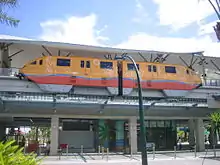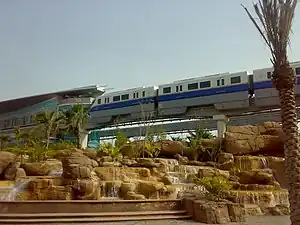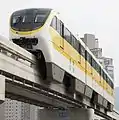Hitachi Monorail
The Hitachi Monorail System refers to the family of monorails offered by Hitachi Rail.

Tama Toshi Monorail, a "Large" Hitachi monorail system
List of notable Hitachi monorails
Hitachi's designs are ALWEG-based, and are available in three configurations:[1]
| Type | Capacity | Axle load | Track beam | Maximum grade | Turning radius |
|---|---|---|---|---|---|
| Large | 415 | 11 t (11 long tons; 12 short tons) | 8.5 m × 15 m (27.89 ft × 49.21 ft) | 6% | 70 m (229.66 ft) |
| Standard | 348 | 10 t (9.8 long tons; 11 short tons) | 8 m × 14 m (26.25 ft × 45.93 ft) | 6% | 70 m (229.66 ft) |
| Small | 194 | 8 t (7.9 long tons; 8.8 short tons) | 7 m × 13 m (22.97 ft × 42.65 ft) | 6% | 40 m (131.23 ft) |
| All specifications as per Hitachi.[2] "Capacity" represents regular load (three passengers per square metre) for a four-car trainset. | |||||
All Hitachi trains except those on Japan's oldest operational monorail have floors entirely above all the wheels.
Large
- Kitakyushu Monorail, opened 1984
- Osaka Monorail, opened 1990
- Tama Toshi Monorail Line, opened 1998
- Chongqing Rail Transit (Line 2 & Line 3), opened 2005 & 2011 (CRRC Changchun Railway Vehicles also took part in the project)
- Panama Metro (Line 3), opening 2025
Standard
- Tokyo Monorail, opened 1964
- Okinawa Urban Monorail, opened 2003
- Palm Jumeirah Monorail, (Dubai, United Arab Emirates) opened April 2009
- Daegu Metro Line 3, (Daegu, South Korea) opened April 2015 (prototype set only, remaining 27 built by Woojin Industrial Systems)
Small
- Sentosa Express (Sentosa, Singapore), opened 2007
Picture gallery
References
- Monorail Delivery Records : HITACHI Archived July 1, 2007, at the Wayback Machine
- System Capacity : HITACHI Archived July 1, 2007, at the Wayback Machine
This article is issued from Wikipedia. The text is licensed under Creative Commons - Attribution - Sharealike. Additional terms may apply for the media files.







